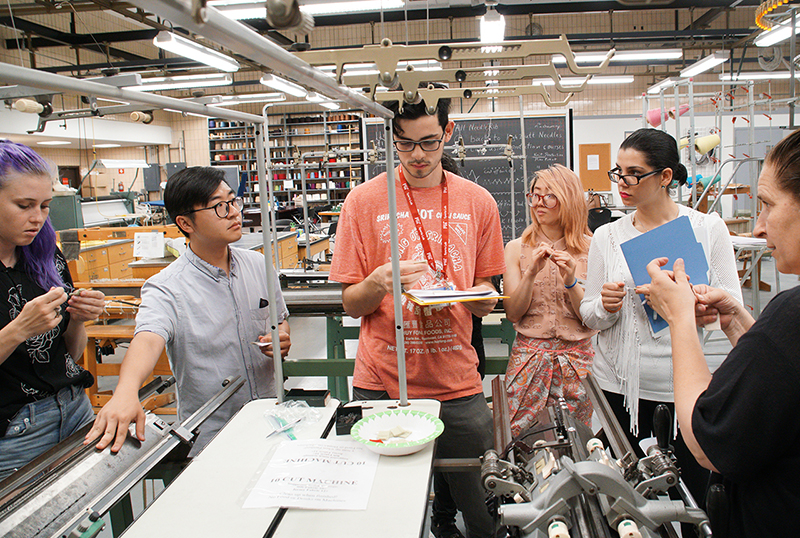A T-shirt that can change color to complement your mood (and help you pare down your wardrobe) … an apron that transforms into a dress and has interchangeable pockets with high-tech functionality … these are the forward-looking concepts presented by a group of three students from Massachusetts Institute of Technology (MIT) and three FIT students making practical use of the latest active textile technologies.
For the first FIT/MIT Summer Workshop, held over two weeks in June, the six students spent one week at MIT in Cambridge and one week at FIT in New York City to explore and develop clothing concepts using advanced functional materials that incorporate 3D printing or advanced knitting technologies. The workshop was held collaboratively with Advanced Functional Fabrics of America (AFFOA), a Cambridge, Massachusetts–based national nonprofit enabling a manufacturing-based transformation of traditional fibers, yarns, and textiles into highly sophisticated integrated and networked devices and systems.
Veronica Apsan, Fashion Design ’18, of Park Ridge, New Jersey, and Erika Anderson of Carlsbad, California, a rising MIT senior who is studying mechanical engineering with a minor in design, conceived a T-shirt that can change color.
“We were really interested in color and how it affects people’s moods and how they feel,” said Anderson. “Color and clothing are part of a person’s identity and how they want to portray that to the world.” Anderson and Apsan started with a color-changing filament that they 3D-printed into modular components. From there, they moved on to hollow fibers that can be filled with an ink that changes color when an electrical current is sent through it.
“Many people own basic clothing or similar shirts and pants in different colors,” Anderson explained. “This takes up a lot of closet space and costs a lot of money.” A large wardrobe is also not environmentally friendly. With a T-shirt that can change color, a person could radically pare down how many garments they buy and throw out.
The four other students in the workshop combined their ideas into a single wearable concept. David Merchan, of Bow, New Hampshire, a rising MIT senior double-majoring in materials science and engineering and physics; Melanie Wong, Fashion Design ’19, of Queens, New York; Calvin Zhong, of New York, NY, a 2018 MIT graduate who double-majored in architecture and comparative media studies; and Jesse Doherty, Fashion Design ’19, created a double-layer knit laboratory apron with reflective zippers that transforms into a dress or bag and has interchangeable pockets with customizable technological functions. For example, one pocket could have an energy socket that wirelessly charges a phone, while another could act as a hand sanitizer by working into the fiber antimicrobial chemicals or ultraviolet LEDs. The apron/dress itself could also be infused with conductive fibers that cool or warm the wearer.
“You could imagine that a lab tech would have different needs than a doctor, who would have different needs than a DIY hobbyist or a shop manager,” explained Zhong.
Using 3D printing, the students knit an open, fully twistable weave mesh for their apron/dress. Once the soluble supports were removed in a chemical bath, the mesh moved in every direction because of the flexible fiber. “The same structure in different materials would behave differently,” noted Doherty.
In addition to conceiving their projects, the students had a packed schedule of workshops, talks, and site visits. While at MIT, they learned about bringing their ideas to market through an intensive entrepreneurship boot camp. They also attended an AFFOA member networking event at the Institute of Contemporary Art in Boston, where Apsan said she and Anderson received positive feedback about their ideas. “The fact that someone in the industry who is working on textiles is thinking the same thing was so awesome to hear,” she said. During their week at FIT, the students visited WGSN, a leading fashion trend, forecast, and analysis service, and met with Gabi Asfour, founder and creative director at threeASFOUR, a clothing design brand, about incorporating 3D-printed parts into garments. MIT and FIT faculty mentors assisted the students throughout the two weeks.
“We believe this is the future, so we want you all to be involved and help make it happen,” AFFOA Chief Executive Officer Yoel Fink told the group.
Gregory C. Rutledge, Lead Principal Investigator for MIT in AFFOA and Lammot du Pont Professor in Chemical Engineering, commented, “It is exciting to see what happens when students from different fields of engineering and design, but with a common interest in advanced fibers and fabrics, come together and engage with new kinds of materials and manufacturing techniques. The collaboration and creativity is inspiring.”
“Combining the talents and skills of FIT and MIT is truly the future,” said Apsan as the two-week workshop wrapped up.
“This workshop validates the benefits of bringing FIT and MIT students together. For this specific workshop, the students explored the possibilities of advanced knitting and 3D printing,” said Joanne Arbuckle, Deputy to the President for Industry Partnerships and Collaborative Programs at FIT. “As the fashion industry becomes more and more dependent on advanced textiles, students who have the experience this workshop has provided will prove to be the industry’s next leaders.”

